Music
My brief single sentence describing the music in the April Fools version of this post wasn’t entirely off the mark. Mortal Kombat’s music is extremely downplayed
to the point that you may not even notice there’s music at all. Where other fighting games have their music
bombastic or energizing, Mortal Kombat goes for ambience. In fact, in Mortal Kombat 9, there’s an
ambience meter in the sound options menu.
It’s more akin to tribal drumming than the
fanfare of other games. There’s
a lot of fast, looping drum beats, techno synth and long notes without any
particular melodies.
Only some of the character select themes use what you might call melodies.
Most of the more recognized music comes from remixes and
alternate adaptations, like the movie, which I’ll get to.
It’d be easy enough to call Mortal Kombat’s music “lame”,
but like the violence, it works with the themes and fits in very
well with the…
Kombat
The evolution of the second part of Mortal Kombat’s title can
be divided into 3 parts of its history: Mortal Kombat 1-4, Deadly Alliance
through Armageddon (as well as the Mortal Kombat vs. DC spin-off) and Mortal
Kombat 9.
Even with these differences through the ages, all the Mortal
Kombat games have consistent mechanics that differentiate it from its fighting
game brethren. For defense, there is a
block button instead of holding back the control stick. For offense, attacks have more windup and
weight to them, emphasizing the blood that results and making it feel more like
an actual struggle of pain and tears rather than a series of
lightning-fast 30-hit combos, punches across the stage and ultra powerful moves
that shatter the earth and leave spectators with epileptic seizures. Think less Kenichi: The Mightiest Disciple and more Bloodsport with the emphasis on blood.
For the first 4 Mortal Kombat games there are two buttons
for kicking, two for punching and one for the guard (MK3 also added a run
button). Like other games, the punch and
kick buttons are for strong and weak punches and kicks. Depending on the position of the control stick, the
punch and kick buttons act as moves such as leg sweeps, flurries of weak
punches and uppercuts, which are more useful than you might expect. A good straight-up
smack to the jaw does a decent amount of damage in Mortal Kombat, almost like
KOF’s knockdown attacks.
Special moves are done similarly to other fighting games too,
just with fewer circular motions and more commands like “down-down-punch” and
“back-back-back-kick.” This makes
many moves feel less like one swift motion and more like quickly typing in the
special attack, which carries over to the combos.
Like other fighting games, performing attacks in quick succession and canceling into each other sets up combos, but starting with Mortal Kombat 3 there are a number of pre-set combos that could be inputted in a way not unlike the 3D fighting game juggernaut Tekken, except in this case the fighter needs to be close in order to use them, which is why the run button helps.
Gamers often call this style of fighting “dial-a-combo”, because inputting the string of button presses doesn’t require timing and are thus input the same way you would dial a phone number or type a word, meaning that you’ll likely finish typing the combo before the character is done executing it. It can be difficult to get used to, but once the timing of canceling these pre-set combos into other moves is mastered, it can lead to even longer hit strings.
Like other fighting games, performing attacks in quick succession and canceling into each other sets up combos, but starting with Mortal Kombat 3 there are a number of pre-set combos that could be inputted in a way not unlike the 3D fighting game juggernaut Tekken, except in this case the fighter needs to be close in order to use them, which is why the run button helps.
Gamers often call this style of fighting “dial-a-combo”, because inputting the string of button presses doesn’t require timing and are thus input the same way you would dial a phone number or type a word, meaning that you’ll likely finish typing the combo before the character is done executing it. It can be difficult to get used to, but once the timing of canceling these pre-set combos into other moves is mastered, it can lead to even longer hit strings.
From Deadly Alliance to Armageddon, the basic controls are
largely the same, but with a grab button and new elements added to drastically
change the playstyle. All of the fights
take place on 3D battlegrounds that allow for sidestepping and ring-outs, and
characters are given new fighting styles to switch to on the fly, often
involving weapons like Kabal’s hookswords, Scorpion’s katana and quadruple-wielding
Goro’s Shokan blades. There are weapons players can pick up in MK4, but here they're a core part of how characters play.
The dial-a-combos return, but this time they aren't as fast and, thanks to more leaning attacks, don't require the attacker to be at point blank range in order to execute them. The combos can get very long and one-sided in these games compared to previous installments (particularly when switching weapons mid-combo), so Deception added a combo-breaking counterattack that can be used three times per
match.
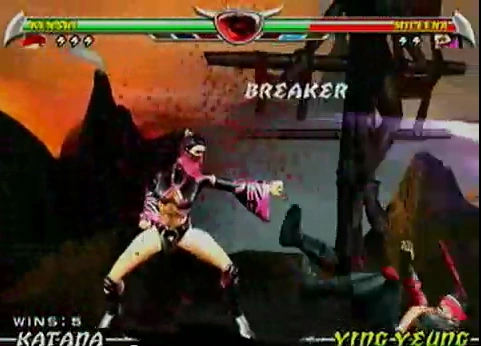 |
| MK vs. DC requires the use of its rage meter. |
The biggest game change in 9, outside of an overall
excellent presentation and sense of finesse, is its three-section meter that fills
as you fight. At the cost of one section
you can use a stronger “ex” version of a special move, much like KOF and Street
Fighter have done in their latest installments.
At the cost of two, you can use a combo-breaking counterattack like in Deception
and with a full meter you can unleash a character’s devastating,
bone-shattering X-ray attack.
True to its name, X-ray attacks zoom in with X-ray vision to
show off how devastating they are. X-ray
attacks are a brilliant answer to the super combos in other games; it’s both
powerful-looking and fitting in with Mortal Kombat’s infamous violence. It’s a little ridiculous how the fighters
should be blind or crippled after a lot of them, but given Mortal Kombat’s
self-awareness, that might have been the intent.
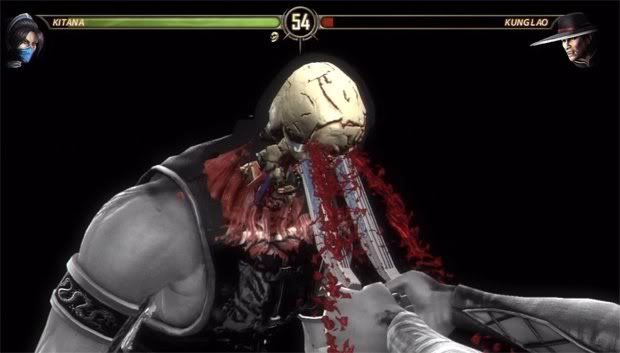 |
| Whoah ouchie. |
In every single Mortal Kombat game, after winning a match, the
game tells you in blood red letters to “finish him/her!”
These words are two of the most famous in all of
gaming. As your opponent helplessly
stands dazed before the winner, the winning player has a few seconds to input a
command to kill his opponent with a glorified, spectacularly
violent-as-all-hell finishing move. They
play no part in the victory, since the winner has already won by that point, but they’re a joy to watch, adding an extra feeling of humiliation and utter
defeat on the part of the loser. They’re
like victory dances that come in many varieties.
To give losers the option to save themselves from that
humiliation, Deception added Hara Kiris, suicide attacks in which the loser
kills themselves instead of be subjected to a fatality. Deception is the only game with them,
however, presumably because they got in the way of the fatalities, the real stars of the show.
Anything less than the most badass fatalities are never well-received by Kamp Kombat. In Armageddon, rather than have each
character use a colorful fatality unique to them, there is instead a
“kreate-a-fatality” system, in which you must input a command for every move of
a progressive fatality, consisting of neck snapping and body part pulling with
canned animations, making it feel more like a procedural surgery than a brutal
coup de grace. This was not
well-received by anyone, especially
when the most likely reason it was conceived was because the developers were
too lazy to animate new fatalities for the characters newly included into
the 3D games.
Doesn’t even use his ice powers.
Mortal Kombat vs. DC Universe was similarly lambasted, this time for having its fatalities be extremely tame and not at all spectacular. As ScrewAttack’s Nick Chester said: “The game’s box says it all. Right there: Mortal Kombat game… Rated T. T! Mortal Kombat shouldn’t be rated T!” How fitting that the entire game was chosen as having the worst fatalities in Mortal Kombat history.
In short, it’s not a Mortal Kombat game without fatalities.
As previously mentioned though, some games offer sillier
finishers like babalities, the non-lethal friendships and animalities, which
aren’t always gory.
Mortal Kombat’s finishing moves are so ubiquitous you can
add “ality” to any word to indicate spectacularly finishing someone off in a
way related to it. Smash a guy’s head
with a book: Bookality. Kill someone in
an elaborate way on accident: Failtality.
Even finishing someone by talking about their feelings:
Therapality! You will never run out of
ways to “finish him!”
But my Kombatant does it best.
Fighter of Choice: Baraka
Baraka is a Tarkatan, a race of mutant Outworld nomads under
the command of Shao Kahn. They are known
for their toothy faces, warped flesh, bloodthirstiness and sharp, retractable
blades that jut from their arms. Among
these battle-crazed warriors, Baraka is the best, and loyal to anyone
who will lead him to a good battle and conquest. Such thinking isn’t entirely unlike someone
like me, who likes to play Mortal Kombat for the thrill of the battle. When he clangs his blades before a fight in
Mortal Kombat 9, I can feel myself doing the same thing.
The way he plays is, admittedly, not a major deciding factor
in what makes Baraka my favorite character.
As a fighter he’s a jack-of-all-stats with powerful close and
long-ranged moves.
He’s easy enough to play as once you get the timing of his special
attacks down and I can put up a good fight with him.
What has always enamored me about Baraka, and probably to a lot of members of Kamp Kombat too, is his visual design. I used to play Mortal Kombat 2 with my best
friend on his Sega Genesis, and Baraka stood out with his distinctly inhuman
face and killer dental work. Being one
who always appreciates uniqueness, I stuck with him.
Later, when Baraka reappeared in Mortal Kombat Deception and Armageddon after it, the memories came flooding back and I stuck with him
out of loyalty, so you could say I have something of a history with Baraka.
His Tarkatan blades are easily my favorite weapons in the
series. They’re built-in, quick to use
(don’t need to put them in a holder), have many potential uses and allow for my
favorite fatalities in the franchise.
They slice, they dice, they make julienne fries and
they’re a big part of what make Baraka my fighter of choice.
Best of the Bunch
Mortal Kombat 9. If
you ask anyone, even fans, which Mortal Kombat is the best one to get they are
most likely going to tell you to buy Mortal Kombat 9. As fun as they can be with friends, every
Mortal Kombat game before 9 has serious flaws that make them very difficult to play by today’s standards.
The original Trilogy has some of the worst cheating,
game-breaking AI I’ve seen since KOF 94.
MK4’s primitive graphics and debatably small character
selection can be hard to overlook.
Mortal Kombat Deadly Alliance to Armageddon have major
improvements, but lack the finesse of other fighters of the time. Too often it feels like fights are a series
of trading overly-long strings of combos rather than a badass supernatural martial
arts battle involving timing and range, and that’s not helped by the really
awkward-looking fighting itself.
To be blunt, the combat moves in Deadly Alliance to
Armageddon look goofy and awkward, as though none of the characters ever
actually trained in martial arts. As the
fighting game website The Fighters Generation stated regarding Scorpion:
“Scorpion wouldn't know Hapkido if it punched him in the
junk. I actually teach Hapkido in real life... (been doing it for almost
20 years) and I can confidently say Scorpion does not perform one
single Hapkido technique. It's okay Scorpion, you're still cool... someone
just lied to you and taught you some fake Hapkido.”
Mortal Kombat 9 changes everything. The story is told in a well-presented story
mode, the bloody and gory presentation is the very best it has ever been,
combat is deeper and has actual finesse, the character selection is impressive
and increased further in the Komplete Edition that includes all the DLC characters,
one of whom is Freddy Krueger! Yes, that one!
Further cementing MK9’s high status is a challenge tower of
300 custom-made challenges, a big krypt of unlockables and several different
modes of play online and offline. Simply
put, Mortal Kombat 9 is the best Mortal Kombat game ever made!
But for those who want an idea of the Mortal Kombat timeline
before 9 changed it all, Mortal Kombat Deception is the best bet thanks to its
own trove of bonuses, decent character selection and single player adventure
mode. Of the different versions the best
one is probably either the Gamecube Version, which includes Shao Kahn and Goro,
or the PSP version titled “Mortal Kombat Unchained”, which includes them plus some
of the omitted characters from Deadly Alliance, all in a portable package.
Kombat 9 has a portable package too. You can get it not only on the PS3, Xbox 360
and PC, but also on the Playstation Vita.
Like Mortal Kombat Unchained, the Vita version's graphics take a hit, but all the content from the Komplete Edition is kept, with a handful of
alternate outfits added for good measure.
This version takes advantage of the Vita’s features to add a few more
bonuses, like balance challenges and a new stage that uses the Vita’s camera to
project the background. It’s a nice deal overall, but you’ll definitely want to stick to the other versions for
the graphical splendor.
Other Media
Like the rest of them, Mortal Kombat has had adaptations of
varying quality. The most well-known is
the live action Mortal Kombat movie. The
copy of Mortal Kombat 9 I got came with a download code to get the entire thing
off of Xbox Live. That shows confidence,
and rightfully so because it’s one of the better game to movie adaptations ever
made.
It retells the events of the first game, staying true to the
source material for the most part while taking liberties with the plot. In fact, the games themselves took a few
ideas from the movie, such as Kano ’s
Australian accent and Outworld having to win 10 Mortal Kombat tournaments in a
row. Lest we forget the movie is also
the origin of the infamous Mortal Kombat theme song everyone online uses
whenever an elaborate martial arts fight breaks out.
Characters and their stories (except Scorpion and Sub Zero)
are just as they are in the game with good acting all around, most notably
Christopher Lambert of Highlander fame as Raiden (though I still prefer Richard Epcar's thunderous voice).
Unfortunately there’s no gore, which you’d think would make
it unrecognizable as a Mortal Kombat movie, but the fighting is still high
flying kung fu action (with good choreography, I might add) and because the
story and characters are consistent to the games, it shows that there’s more to
Mortal Kombat’s identity than the violence.
It does help to have it, of course.
Couple all of that with some cheesy special effects and an
awesome Goro animatronic and you have a fun fight-centric movie.
And they got The Big Man voicing Goro!
The movie’s sequel, Mortal Kombat: Annihilation, is held in
much lower regard.
Mortal Kombat: Annihilation attempts to retell the events of Mortal Kombat
3, skipping the Outworld tournament and moving on to Shao Kahn merging the
realms. Not one to skip over potential
though, it uses characters from both Mortal Kombat 2 and 3. Too many, in fact.
So many characters are crammed into the movie almost none
get enough screen time for character establishment or backstory. Cyrax, Jade, Mileena, Baraka, Smoke and more
all come and go with only a few lines, if any.
Like the first, it takes some interesting liberties with the source
material, like Kahn and Raiden being brothers and animalities being an inner
spirit beast-type concept, but it’s hard to take anything as seriously in
Annihilation when it’s overshadowed by how amazingly cheesy it is.
On top of the hammy acting (due in part to a massive cast
change), the fights have lots of flipping around and dated special effects much
worse than the first movie.
You can tell they were trying to make a faithful adaptation
of the games, it just wasn’t handled well.
Fans of the games and/or so-bad-it’s-good movies will probably get a
kick out of it, if nothing else. At
least they didn’t just slap the character names on a completely unrelated movie
like in that one we must never speak of again.
Both Mortal Kombat movies have animated supplementary material
to go along with them. The first is Mortal Kombat: The Journey Begins, an animated short retelling the events of
the Earthrealm fighters’ arrival on Shang Tsung’s island in the first
movie. The second is a 13-episode
animated series called Mortal Kombat: Defenders of the Realm.
The best you can say about them is that you can feel the
pain and suffering in the franchise pretty well when watching them.
Alas, it didn’t end there.
There was one more TV excursion after Defenders of the Realm,
this time in a live action show, Mortal Kombat: Conquest. Conquest is a side-story series that details
the lives of The Great Kung Lao, back when he was the champion of Mortal
Kombat. He and his allies Siro and Taja fight Shao
Kahn’s evil forces throughout the series.
One word can best describe Conquest: Cheap. Cheap props, cheap sets, cheap effects, cheap
actors and cheap fight scenes. The whole
thing is mostly a monster-of-the-week-style show with not nearly as much action
as you would expect. Even when there is
action the fight scenes are boring and brief, with no impressive stunt work or
cinematography like in the movies. Again, there’s also no gore.
The writing doesn’t help it.
Characters are badly written, inconsistent and/or dull. There’s simply nothing of substance. You can tell there wasn’t a whole lot of
effort put into Conquest. It’s
completely forgettable aside from maybe its ending, which is one of the only
things those of Kamp Kombat make note of.
Many years later, in 2011, a new, much more competent Mortal
Kombat series took off, this time on the internet. Following an impressive short film based on
the franchise called Mortal Kombat: Rebirth, small-time director Kevin Tancharoen
was brought on to make the live action series Mortal Kombat: Legacy.
Rather than get involved in the main plotlines, Legacy is an
anthology series telling individual stories of different characters, which it does admirably, for a series of shorts.
It even has actual blood for once.
It doesn’t have the budget of the movies, which shows
in some of its lackluster digital effects, but the fighting, acting and Kill
Bill-style animated segments show a lot effort. I recommend at least watching a few
episodes. They’re available on Youtube
and Steam, including a second season titled as a sequel.
The motion capture here is pretty damn impressive.
Like everyone else except Skullgirls, Mortal Kombat has had
its own comics too, each from different publishers.
Several different comics have been made by Midway themselves
to promote the release of certain games.
Similarly to the Batman: Arkham
City
I can’t attest to the quality of the Midway comics, but I wager they’re significantly better than the Mortal Kombat comics by Malibu . You may remember Malibu
from way back in camp Street Fighter , where
their godawful adaptation of the franchise is flogged and laughed at.
The Mortal Kombat Malibu comics do not fare much
better. Admittedly, the Rob
Leifeld-esque artwork is a little less jarring than with Street Fighter, since
Mortal Kombat is full of grit and muscular guys anyway, but it’s still
laughable.
Outside of the character designs and names, the writing is way off from the games, but that can be forgiven since they didn’t
have all that much to work with at the time.
Even so, what they came up with is bland and forgettable at best. The only thing from it anyone remembers
is the Lin Kuei water fighter Hydro (shown as a Cyborg in the clip from Legacy
a few paragraphs back).
As you can tell, Mortal Kombat was extremely popular in the 90s in particular. So popular it also got its own stage show, much like the Teenage Mutant Ninja Turtles
did. Performers dressed as the different
Mortal Kombat characters would fight each other on stage to a lazer light show.
Sadly, this one was never released on video or DVD and you
can’t even find footage of the actual performances online so once again I can’t
speak for its quality. Supposedly it was
about as embarrassing as TMNT’s Coming Out of Our Shells tour, full of
family-friendly violence and dubbed voice overs. I wish I could have seen it myself.
What you can see
online is probably worse anyway. In 2000,
a web activity of sorts called Mortal Kombat: Federation of the Martial Arts brought the audience in on the action. The way it worked was that participants were given fake currency to bet on staged fights that were released in videos every
week, and those who had the most money were given prizes.
It’s a fun concept that should have been a success given
that costumes from the movie were used for the fights. Unfortunately, they’re absolutely terrible.
While some of the movie's and Conquest’s actors did come back
for FOTMA, at times they had to use stock footage of the actors, and that never comes out well.
The fight scenes themselves seem to have been recorded without any sound, meaning crappy voice acting and sound effects were added in later, as were the chroma-keyed backgrounds. The digital effects look like they came from early 90s FMV games, even moreso because every video is horribly compressed and runs at a choppy framerate akin to 3D games on the Atari Jaguar. Out of all the stupid Mortal Kombat spin-off material, this one is probably the worst. How fitting that the director went on to make the often-mocked CGI movie Food Fight.
The fight scenes themselves seem to have been recorded without any sound, meaning crappy voice acting and sound effects were added in later, as were the chroma-keyed backgrounds. The digital effects look like they came from early 90s FMV games, even moreso because every video is horribly compressed and runs at a choppy framerate akin to 3D games on the Atari Jaguar. Out of all the stupid Mortal Kombat spin-off material, this one is probably the worst. How fitting that the director went on to make the often-mocked CGI movie Food Fight.
Mortal Kombat has had quite a history. With so many changes and extra material, it has resulted in one of the longest Fighting Game Camp articles to
date, falling just behind Blazblue’s insane plot. Its western player focus has given it a long-lasting identity that has yet to be successfully replicated, and for players that have played the hell out of the Japanese fighters, it can be a fun break.
Now that its history has been reset on a new generation of game
systems, Mortal Kombat is only going to get bigger once again. It’s a game about fatalities, but it itself
is never going to die.
Just like the characters.
Just like the characters.

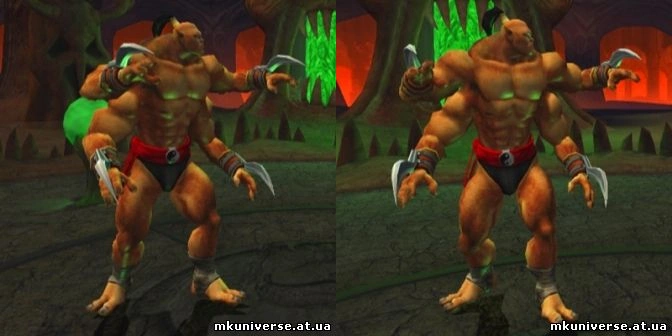
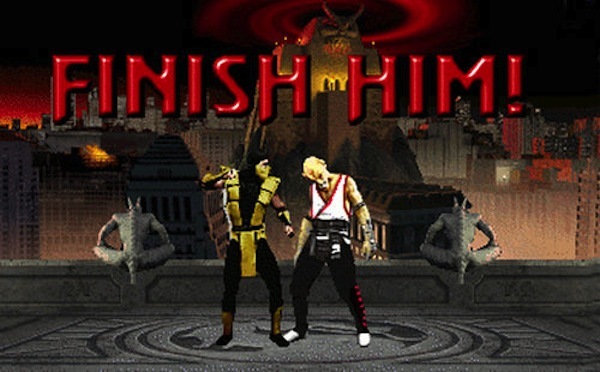
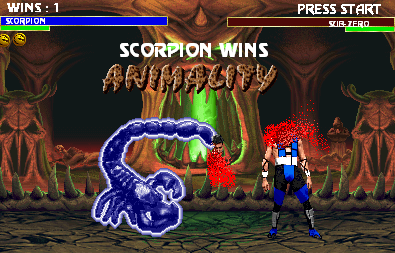





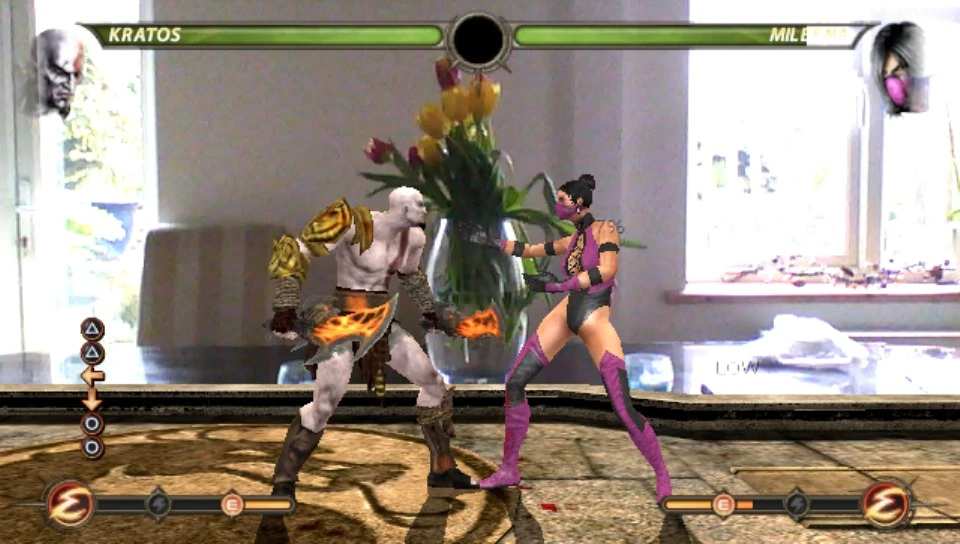
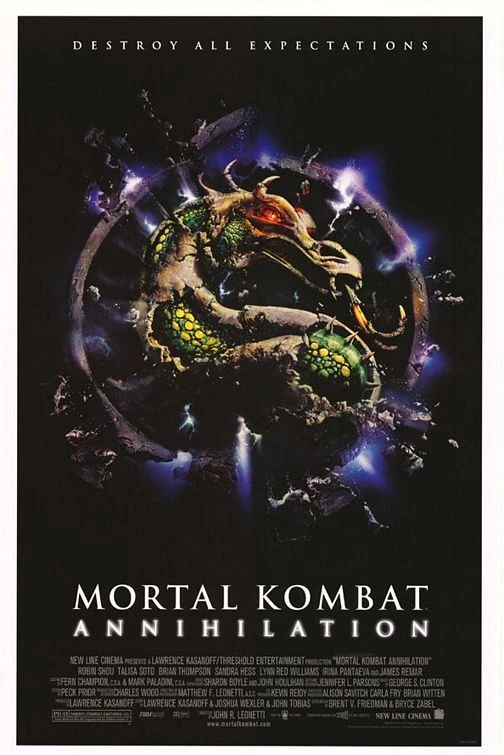

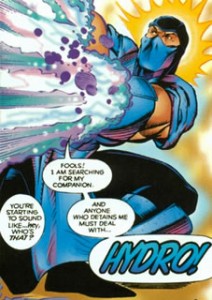

I don’t understand this....???
ReplyDeletebeuitiful post...???
ReplyDelete